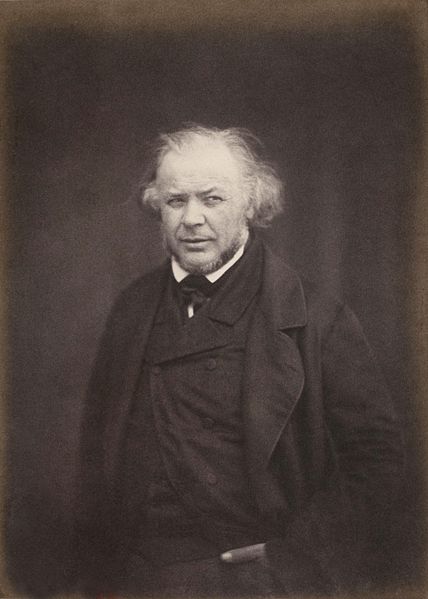
Born: 26 February 1808, Marseille
Died: 10 February 1879 (aged 70)
Period: Realism
The Life of Honoré Daumier
Honoré Daumier was a prolific French artist known for his influential caricatures, paintings, and sculptures that critiqued the social and political landscape of 19th-century France. Born in Marseille, Daumier moved to Paris with his family in his youth. Although he initially trained to become a draftsman and a lithographer, he soon made a name for himself as a caricaturist, contributing to various newspapers and magazines such as La Caricature and Le Charivari.
Daumier’s early work was marked by sharp political satire directed at government officials, the monarchy, and the bourgeoisie, which often got him into trouble. His most notorious lithograph, “Gargantua” (1831), depicted King Louis-Philippe as a greedy giant swallowing the wealth of the poor, leading to Daumier’s imprisonment for six months in Sainte-Pélagie prison.
Despite the risks, Daumier continued to produce works that commented on the social injustices, inequality, and the absurdities of legal systems, making him a champion of the working class. His caricatures were celebrated for their wit, insight, and the skill with which he captured his subjects’ essence. Beyond his lithographs, Daumier was also a talented painter and sculptor, although much of this work was not fully appreciated until after his death. His paintings often depicted everyday life with a sympathetic portrayal of common people, showing the same keen observation and emotional depth as his caricatures.
In his later years, Daumier’s eyesight began to fail, which affected his ability to work. He lived in poverty towards the end of his life and was supported by a pension funded by admirers and friends. Daumier died in Valmondois, north of Paris, leaving behind a vast oeuvre that influenced many later artists, including the Impressionists and Realists.
Today, Honoré Daumier is regarded as one of the foremost social commentators of the 19th century through his art. His works are preserved in many major museums around the world, where they continue to be celebrated for their powerful critique of society and their profound humanism.
Honoré Daumier’s Notable Works
Honoré Daumier, a master of caricature and a poignant social commentator, created a vast body of work that includes lithographs, paintings, and sculptures. His keen observations of 19th-century French society, combined with his wit and artistic skill, have made several of his works iconic. Here are ten of Daumier’s most famous and impactful creations:
- Gargantua (1831) – A lithograph caricature portraying King Louis-Philippe as a giant greedily consuming the wealth of the poor, symbolizing corruption and greed in the French monarchy. This work led to Daumier’s imprisonment.
- Rue Transnonain, le 15 Avril 1834 (1834) – A powerful lithograph depicting the aftermath of a government massacre in a worker’s apartment, showcasing Daumier’s skill in capturing human tragedy and injustice.
- The Third-Class Carriage (c. 1862-1864) – A painting that compassionately depicts the cramped conditions of ordinary people traveling in a third-class railway carriage, highlighting Daumier’s empathy for the lower classes.
- The Legislative Belly (Ventra Legislatif) (1834) – A caricature representing the French Chamber of Deputies as a group of bloated, self-satisfied bourgeois men, critiquing the political corruption of the time.
- The Uprising (c. 1860-1870) – A painting that is believed to depict the spirit of revolution and the struggle for justice, capturing the tension and determination of the people in the face of oppression.
- The Print Collector (Le collectionneur d’estampes) (c. 1857-1863) – A painting that provides a more personal and introspective look at the art world, depicting an elderly man admiring his print collection.
- Don Quixote and Sancho Panza (c. 1868) – A painting illustrating the famous characters from Miguel de Cervantes’ novel, showcasing Daumier’s interest in themes of fantasy versus reality.
- Lawyers and Judges (Les Gens de Justice) (c. 1845-1850) – A series of lithographs satirizing the French legal system, portraying lawyers, judges, and plaintiffs in various scenes of courtroom drama and legal transactions, often highlighting the absurdity and corruption within the legal profession.
- The Miller, His Son, and the Donkey (c. 1849) – Part of Daumier’s series of lithographs based on Aesop’s fables, this work uses the story to comment on the fickleness of public opinion and the impossibility of pleasing everyone.
- Crispin and Scapin (c. 1858-1860) – A painting depicting two characters from Molière’s play, highlighting Daumier’s interest in theatrical subjects and his ability to capture the essence of dramatic performance.
These works represent just a fraction of Daumier’s prolific output but highlight his range as an artist, from his biting political caricatures to his sympathetic portrayals of everyday life. His legacy endures in the poignant social critique and humanity evident in his art.